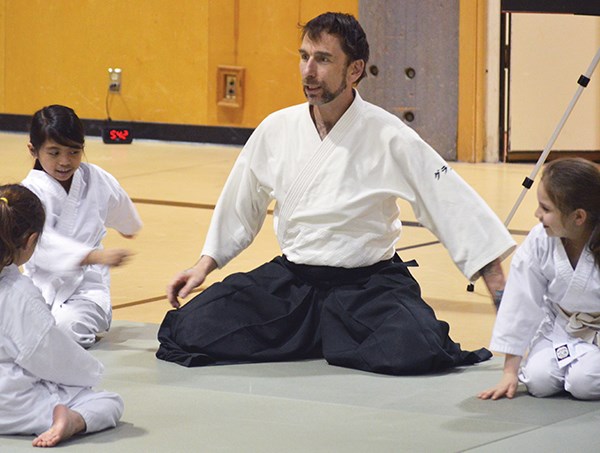For Grant Babin, aikido has provided a sense of structure and balance. Now, the Squamish newcomer hopes to pass on what he has learned to young people in the community.
He has joined with the Squamish Budo Society (formerly the��Aikido Squamish Society) and their partners at the Squamish Nation to offer aikido classes for young people on Thursday nights at Totem Hall.
“He’s just going to be an awesome addition to Squamish,” said the Budo Society’s Carl Merac. “It was any easy choice for us.”
The program is part of an anti-bullying initiative, and Babin feels aikido is the perfect martial art for this. Unlike other disciplines, which are combative and competitive, aikido is focussed on using inner power rather than sparring. It is more about using an attacker’s balance against him.
“Aikido’s unique compared to all the other martial arts,” Babin said. “The object is not to hurt the person, which is really difficult to do…. You’re trying just to control them.”
Already, the program has opened up some issues for the young students.��
“In our classes we address problems such as bullying,” Merac said. “One of our important aspects is anti-bullying… anti-violence.”��
One girl, early on, seemed hesitant to take part. Organizers learned she was being bullied within the class, so they talked with the bullying student and found that that student was also dealing with a bully.
Babin has studied other martial arts, but for him, aikido has brought him structure – or an “anchor.”
Originally from Quebec, he moved to Vancouver in 1990, but he said he was homeless and facing troubles before he started taking classes in Vancouver.��
“I’d been living on the street a lot.”
Of all the martial arts, he likes the discipline from aikido as well as it non-combative principles.
“It gave me some structure,” he said. “Aikido’s like a moving meditation.”
Babin’s instructor, Michael St. Germain, and others there then pushed him to continue further and become a teacher, focussing on instruction for young people.
He went to Japan to teach young students and spent a few years there, then he was contacted by the Budo Society about replacing an instructor who had moved to Japan to teach at a dojo.
“I was planning to come back to Canada in the next couple of years,” he said.
The martial arts training, itself, is only part of the program with the kids, which also involves social aspects such as dinners with the kids after class as well as First Nations or Japanese cultural activities.
It is also just part of what the Budo Society is doing, as it is forming a group called the Positive Pathway Foundation with initiatives for food recycling and cooperative growing, a “real social program,” as Merac describes it.��
“Our main goal is to take what we’re learning on the mat and take it out to the community,” he said.
Budo is also partnering with Quest University to offer aikido on campus at 7 a.m. during the week, and students can even work their way up to a black belt if they attend regularly.
��
Babin and Merac emphasizes that because of the non-competitive aspect of aikido, the martial art is ideal for people to start at any time because the students can learn at their own pace.



